Essen in Autumn
Pevans hits Spiel '17
This is my report from the 2017 Spiel games fair in Essen, Germany. It is written as a narrative, to be read through from the start, but you can also use the links below for the list of exhibitors, list of games and sections of the report. This is the first version of the report, covering games I played or saw at the show. I will expand this with my experiences of more games as I played them.
- List of Exhibitors
- List of Games
- Introduction
- Making an entrance (Thursday)
- Staying late on Friday
- Fighting the crowds on Saturday
- Wrapping up the loose ends on Sunday
It is also available as a PDF document: Spiel '17 report (4 Mb). (You will need Adobe Reader to view this document – use the link to download it if necessary.)
List of exhibitors
This list is the exhibitors I mention in the report: click on the name to go to that section.
| Name |
|---|
| 2Tomatoes |
| 4Hogs |
| Abacusspiele |
| Asyncron Games |
| Desyllas Games |
| eggertspiele |
| Fowers Games |
| Freod |
| Game Brewer |
| Hans im Glück |
| Jet Games Studio |
| Lautapelit |
| Name |
|---|
| Lunatic Board Games |
| MESA Boardgames |
| Moaideas Game Design |
| Osprey Games |
| Ostia Spiele |
| Pegasus Spiele |
| Placentia Games |
| Ravensburger |
| Spaceballoon Games |
| Wattsalpoag |
| Wizkids |
List of games
This list is links to my notes on the games I saw and played during the show. I will add more as I play them.
| Title | Publisher |
My rating* |
|---|---|---|
| Brides & Bribes | Spaceballoon Games | 8** |
| Castellum | Game Brewer | 6* |
| Crop Circles | Freod | 6* |
| Dokmus | Lautapelit | 8* |
| Echidna Shuffle | Wattsalpoag | 8 |
| El Dorado, The Quest for | Ravensburger | 8* |
| Empires | Wizkids | 9* |
| Fugitive | Fowers Games | 8 |
| Majesty | Hans im Glück/Z-Man Games | 7* |
| Noria | Pegasus Spiele/Stronghold Games | 9* |
| Parley | Lunatic Board Games | - |
| Peak Oil | 2Tomatoes | 8* |
| Pelegrinus (prototype) | Asyncron Games | 7** |
| Reworld | eggertspiele/Plan B Games | 9* |
| Riga | Ostia Spiele | 7** |
| Skull Port | 4Hogs | 7* |
| Sultans of the Wind | Desyllas Games | 7* |
| Surge: Battle for the Oleshky Sands | Freod | 6* |
| Tulip Bubble | Moaideas Game Design | 8** |
| Viral | MESA Boardgames/Arcane Wonders | 8* |
| War of the Worlds: The New Wave | Jet Games Studio | 7* |
| Wendake | Placentia | 7** |
| * Provisional rating, based on playing once ** Enthusiasm rating, based on a demo |
||
Introduction
This year's Spiel games fair was a week later in October than it has been in recent years. Since this means the weekend included an extra hour as the clocks went back, I'm not complaining. Nor do I have much to complain about in my journey to and from Essen. I feared the worst when a car in front of me wouldn't start after the Eurotunnel train arrived in Calais. Judging by the staff's swift response, this was something they were used to. They reversed a van into the carriage, jump-started the recalcitrant vehicle and I was on my way after no more than ten minutes.
The annual Spiel games fair probably needs no introduction, but it is the biggest board games-focussed event in the world (plenty of other types of games get a look-in, too). Spread over four days at the Messe (exhibition halls) in Essen, Germany, this year's event saw 182,000 unique visitors peruse over 1,200 new releases provided by 1,100 exhibitors from 51 countries (according to the official figures from the organisers, Friedhelm Merz Verlag).

Queuing outside the West entrance (which leads into Hall 3)
Making an entrance
The event - and the number of games - is just too big to be able to cover everything, so my report is, of necessity, just about what I saw while I was there. (The perennial refrain after Spiel is: "Did you see...?" "No, where was that?!") Nor do I get the chance to play very many of the new games, despite spending four days at the show. Hence, my initial report includes the games I did play and those I looked at. I will then add to it as I play more of the games.
The first day of Spiel '17 was unseasonably warm, but this had little impact on activity inside the exhibition halls. This year, Hall 8 was in use, more than making up for the disappearance of Hall 4 (literally: there's just space where it was last year). As re-development work continues at the Messe, Spiel was taking up all the usable space as far as I could see (the new East entrance building looked to be largely complete, but was still being worked on, along with the older halls).

Construction continues on the revamped East entrance building
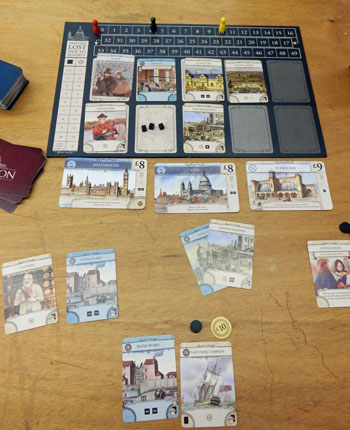
London on display
With my usual gaming buddy, Pete Card, my visit started in hall 7 where Pete and I spotted Osprey Games. The attraction here was their new edition of Martin Wallace's London. The key difference that I could see is that this edition has no board, removing the geographical element from the game. This probably does not have a huge impact as it is essentially a card game: players build up their own 'London' by playing cards and then 'run' the buildings to gain rewards. However, this also produces 'poverty', which can have a major impact on the final scores. I really enjoy the original game and will be interested to see how the second edition works.
We then spotted the Hawaiian shirts of the Wattsalpoag team and trotted over to chat to our old buddy, main man Kris Gould. He had a couple of pre-production copies of his latest design, Echidna Shuffle, so we sat down and gave it a go (having played the prototype at the Gathering, I thought I had an advantage - how wrong can you be?). This features cute little echidna models as the playing pieces, along with different insects for each player. The board shows the paths the echidnas move along and the initial set-up is important: placing your goal and other players' insects around the board.
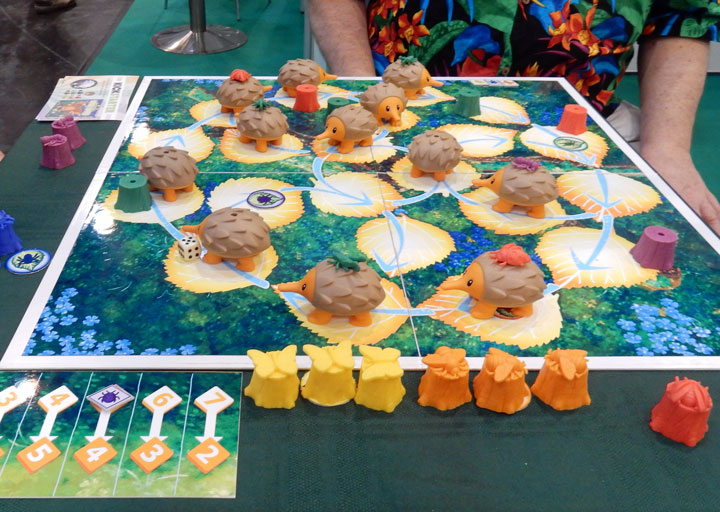
Echidnas shuffling nicely – with Kris’s shirt in the background
Players roll a die and then move the echidnas. Except it's not that simple. To start with, rolling a '6' may be good this turn, but it means your move next turn will be just three spaces. Whereas rolling a '3' may constrain you this turn, but lets you move six spaces next turn. And you don't just move your own pieces, you can move any echidna. This gives plenty of scope for moving opponents' pieces onto paths that will take them away from where they want to go. The final point is that echidnas can't move through each other. Thus, to move the one you want will often require shuffling several others along first - hence the game's title.
Okay, it's not the deepest game, but it is a delight to play and does provide some interesting tactical decisions. Along with plenty of opportunities to sabotage your opponents. And what other game gives you a box full of echidnas? Echidna Shuffle is on Kickstarter now, so go and take a look. It gets 8/10 on my highly subjective scale and I look forward to getting my hands on a copy.
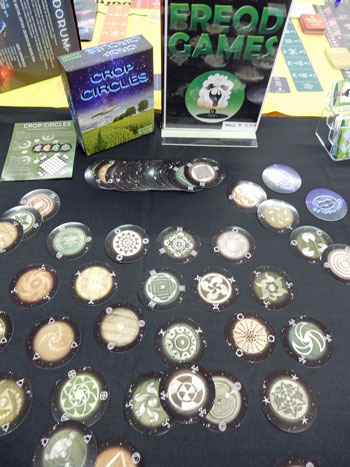
Crop Circles on display, showing off the designs
Freod is a new name to me, but these Aussie publishers had a couple of games to show us. We gave Crop Circles a go first, intrigued by the round cards used in the game. These are illustrated with real crop circles - I was surprised how ornate some of the designs were, given they're made by a couple of blokes with planks strapped to their feet. Or are they...?
Anyway, the game starts with a grid of face-down cards in the centre and an initial set of cards with each player - some face-up, some face-down. In their turn, players turn over a card in the grid. Then they can choose whether to swap it for one of the cards in front of them. Each card has a symbol on it (representing the type of crop circle) and the aim is to get a row of four showing the same symbol. It is, of course, very easy for an opponent to stop a row of three - or, indeed, complete it for themselves. Thus, players must take a more subtle approach to establishing groups. Of course, as more cards are revealed, this becomes easier.
A completed set is removed to the player's scoring pile and replaced with fresh face-down cards. A neat touch here is that this does not necessarily disrupt your opponent's plans. The game continues until one player reaches the magic number and is declared the winner. Crop Circles is a neat game with some tactical decisions, but not one I feel the need to play again. It gets a provisional 6/10 on my highly subjective scale.
Freod's second game was Surge, a two-player Cold War confrontation. Although players are deploying military units on the board, it's not really a wargame. In fact, I found it quite an abstract game. It's played until the deck of cards runs out, with the winner being the player who controls more regions - unless one player can achieve an overwhelming victory beforehand. Each round, the first player selects cards to deploy (giving the unit type and terrain they appear in) and to keep for next round, discarding any excess.
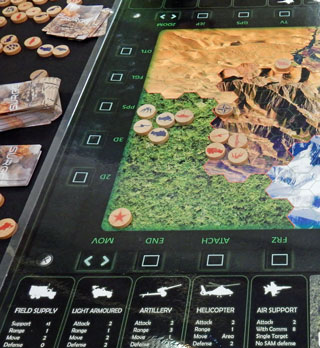
Part of the Surge game: I hold the mountains,
but Pete’s taken the jungle
The second player then chooses and places their cards before the first player actually places their units, now taking into account what they can see of their opponent's plans. They may then attack, hopefully eliminating an enemy unit, but the positioning of pieces is at least as important as attacking. The first player then deploys their next set of cards before their opponent takes their turn.
There are several elements of the game that make it interesting: the interaction of the different terrains and regions - players have limited scope to move units, just to add another factor. As you'd expect, units have different attack and defence values. However, some units provide 'support', increasing other units' values according to where they're placed. The sequence of play is also interesting, with players constrained by the cards they have available, but having the chance to react to their opponent's plans. It's clever, but it's not my cup of tea, so Surge gets a provisional 6/10 on my highly subjective scale.
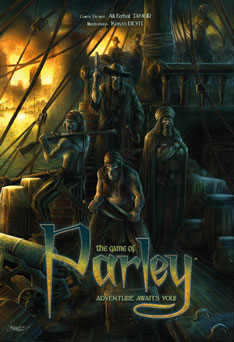 Straying into Hall 8 we found Turkish publisher Lunatic Board Games with Parley, designed by Ali Ferhat Tamur. This is a game of 16th century pirates in the Mediterranean. Or should that be privateers? Secretly, each player has allegiance to one of the major Mediterranean powers and is working to gain this nation dominance over the ports around the sea. One entertaining aspect of the game
is that if you can guess
a player's allegiance, you can blackmail them.
Straying into Hall 8 we found Turkish publisher Lunatic Board Games with Parley, designed by Ali Ferhat Tamur. This is a game of 16th century pirates in the Mediterranean. Or should that be privateers? Secretly, each player has allegiance to one of the major Mediterranean powers and is working to gain this nation dominance over the ports around the sea. One entertaining aspect of the game
is that if you can guess
a player's allegiance, you can blackmail them.
The game is played through a sequence of sieges, ending when every port on the board has been besieged. Players then reveal who they were working for. They gain points for the number of ports under that country's control as well as for the amount of cash they've managed to gather - mainly from blackmail. We were both quite taken with the game and I picked up a copy, so expect a review when I've had the chance to play it a few times.
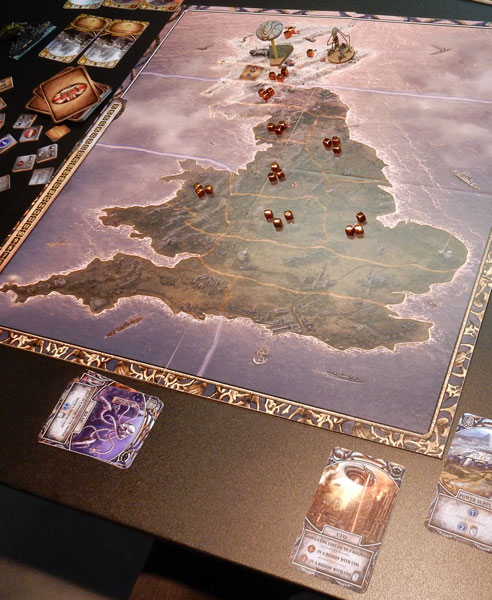
The War of the Worlds begins…
Continuing round Hall 8, we discovered Russian publisher Jet Games Studio with War of the Worlds: the New Wave (designed by Denis Plastinin). This has HG Wells's Martians making a second invasion of Britain to face WW1 era military. It's essentially a two-player wargame across a map of Britain with some terrific models - flying saucers and be-tentacled tripods versus tanks and dreadnaughts. It looks terrific and we stopped to give it a go.
The main mechanism is Dominion-style decks of cards, from which players draw a hand to play each turn. Apart from using cards to move pieces (population cubes as well as the models), they can be used to buy additional forces - the humans don't start with any tanks or dreadnaughts deployed, nor are there any tripods - or construct fortifications. The Martians win if they remove all the population. Humanity wins if they inflict enough damage (marked on a track) on the invaders (no convenient plague this time!). In both cases, the magic number is 30.
With the Martians having landed in the Scottish Highlands, Pete led them on a killing spree further and further south (and mopping up Scotland). Card purchases saw him deploying heat rays, black smoke and the scary ululations of the tripods. I carried out an increasingly desperate defence, trying to stop the invaders with minefields, fortifications and one tank. Things looked bad when the Martians started eliminating the human population from their saucer as the defending forces couldn't touch it. However, I was able to get a last attack on a tripod and win 30:28. Humanity survives!
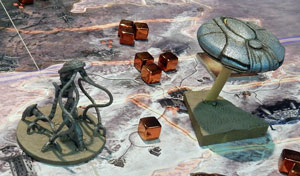
Did I mention the tripods are seriously creepy?
War of the Worlds: the New Wave was good fun, though we both made mistakes in trashing cards we should have kept (I suddenly found it difficult to buy any new cards). And the look of the game is wonderful, with the tripod models being particularly creepy. It gets a provisional 7/10 on my highly subjective scale and I suggest giving it a go if you get the chance.
Staying late on Friday
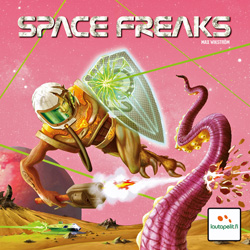 Friday morning saw Pete and me in the barn that is Hall 3. Here we came to Finnish publisher Lautapelit. Apart from an array of expansions (including one for last year's excellent cycle racing game, Flamme Rouge), the new game the Finns were pushing was Space Freaks.
Designed by Max Wikström, this is an arena battle game where players first construct a monstrous
creature before fighting it out with the other players. The game stood out mainly because of its lurid pink box. Despite this, we gave it a miss.
Friday morning saw Pete and me in the barn that is Hall 3. Here we came to Finnish publisher Lautapelit. Apart from an array of expansions (including one for last year's excellent cycle racing game, Flamme Rouge), the new game the Finns were pushing was Space Freaks.
Designed by Max Wikström, this is an arena battle game where players first construct a monstrous
creature before fighting it out with the other players. The game stood out mainly because of its lurid pink box. Despite this, we gave it a miss.
Instead, we sat down with designer Mikko Punakallio to try last year's Dokmus. This played across eight square boards showing different terrain and laid out in a 3 x 3 grid. Yes, there's a space. This is because one of the actions available in the game is to slide a row or column of boards into the space. The object of the game is to grab territory by placing neat triangular wooden pieces in your colour (they're meant to be your expedition's tents). Normally, each tent must go orthogonally adjacent to another of your pieces, making progress across the boards pretty slow. Until you start sliding the boards around. Or turn one round, which is another of the actions available.
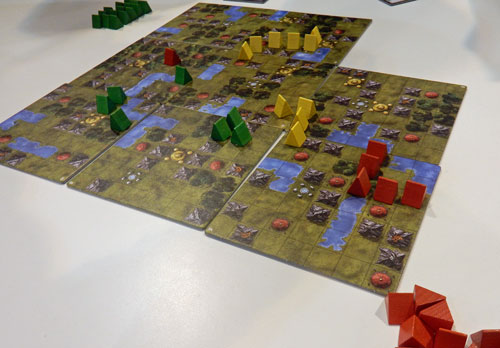
Playing Dokmus: a bit of board shuffling has got red right over the other side
At the start of each round, players choose one of the 'guardian spirits', which is what gives them the ability to slide or turn a board - amongst others. Then they place their pieces, spreading across the boards, using their special ability and potentially triggering other things. Crossing water or entering a forest requires the sacrifice of one piece. This can get expensive, but there is a bonus at the end of the game for the player who's sacrificed most pieces - one of many neat touches in the game.
The game is played over eight rounds and players then score for the 'temple' spaces their pieces are next to on the boards. They also get a bonus for the number of different boards they score and another bonus for getting all the temples on a board (relatively easy when a board has only 4 temples, much tougher when it has 8). There is quite an abstract feel to Dokmus and you really have to think, but I still thoroughly enjoyed the game. It gets a provisional 8/10 on my highly subjective scale.
What we didn't try was the new expansion for Dokums: Return of Erefel. This complicates the game further by introducing roads. These let you extend further, placing pieces a space away from an existing piece, as long as you stay on the roads. However, players need to leave the roads to get to the temples. It also adds another guardian spirit, the eponymous Erefel, giving players another choice in special ability to use each round. The game can also be changed by choosing a particular season, which alters what players can do. All good stuff to shake up anyone who's got familiar with the base game.
When I first started visiting Spiel, Hans im Glück was one of the must-see publishers. Now there are so many publishers producing good games, they're not as crucial, but usually have something interesting. This year it was Majesty, designed by Marc André. Pete and I jumped at the chance to try it and were joined by two delightful Germans who were happy to play in English (with occasional clarifications from the German rules).
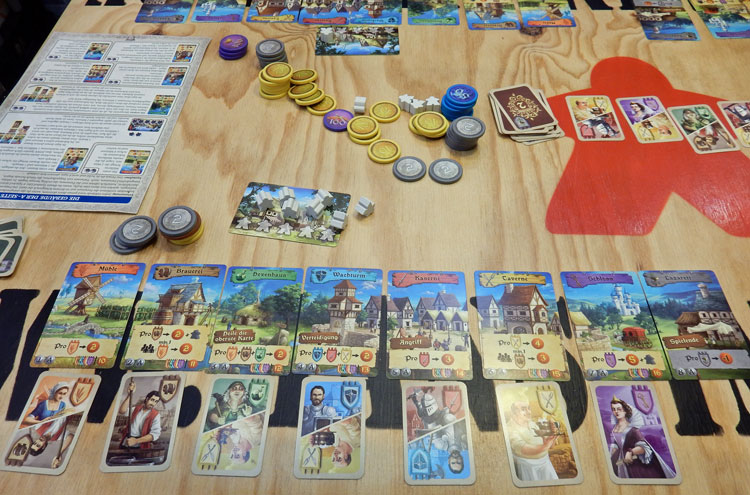
Majesty in play – having somebody in each building except the infirmary must be good, eh?
Each player starts with an array of buildings - cards laid out in front of them - and some (generic) meeples. The game starts with a line of character cards available to buy from the centre. They can be bought by placing a meeple on each card along the row before the one you want - these meeples will go to whoever buys that card, incentivising less useful cards as the game goes on. The purchased character is assigned to its matching building, triggering the actions of that building and any characters with it.
Thus, buying a 'Knight' means you attack your opponent, sending their characters to their infirmary. Unless they have enough 'Guards' to block the attack. Cards in the infirmary are penalty points at the end of the game. Unless you buy 'Witches' to heal them. Other actions include gaining extra meeples and scoring points (cardboard chips) for different characters you hold.
The game ends when all players have a dozen characters. They then score for the number of different buildings these are assigned to. Players also get points for having the most characters in each different building type. And the player with the most points wins, of course. Majesty is rather lighter than vintage Hans im Glück games, but it is good fun. It's also more demanding than might at first appear: the key is keeping a careful eye on what your opponents are up to and what they might be able to do... It gets a provisional 7/10 on my highly subjective scale. (the English language edition comes from Z-Man Games.)
Friday evening was something different: this year Pegasus Spiele was holding games nights on their stand and we went along that evening. The way this worked was that the Pegasus stand was open to ticket holders from 7 pm (when Spiel closed for the day) through to 1 am (though I didn't expect to stay that long). All the games Pegasus publish and distribute were available, along with Pegasus's team of demonstrators to explain and assist. A hot and cold buffet was available, along with soft drinks, and everybody got a goody bag on departure. It was an excellent opportunity to try some games without the usual crush and noise of the show and Pete and I were joined by John Mitchell.
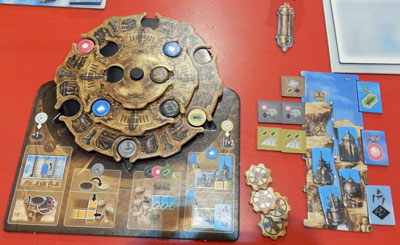
The ingenious Noria mechanism: turn clockwise!
Our first game was a weighty beast: Noria, designed by Sophia Wagner and published by Pegasus - with the English language edition coming from Stronghold Games. The game's setting, Noria, is a flying island, which provides some atmospheric artwork for the game. Not least on the main game board, where Noria is depicted with scoring and game round tracks super-imposed.
Each player gets their own bits and pieces as well. Chief of these is the ingenious device that controls what actions the player can do in their turn. This is a circular plastic base with three levels. A cardboard ring sets on each level with slots for action chips to be slotted in. At the end of their turn, the player rotates their rings (clockwise - no, Paul: clockwise!) so that a different set (three at most) of actions is in the front half and available for their next turn. A small board slots on to the front of this and shows reminders of the actions.
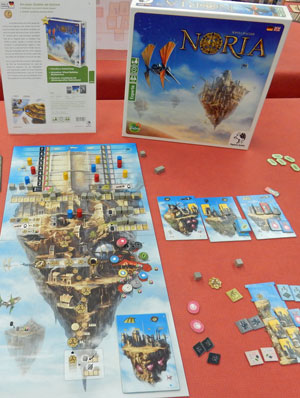
The full Noria display
The obvious actions are taking some basic resources (there are three types), according to the number of ships (more striking illustrations) of that type they have docked at their base. The movement action lets the player move their 'Ambassador' pawn to one of the outlying islands (small boards). Here they can either take a ship, docking it at their base, or place one of their 'Factories'. The factories allow the production of more complex goods, according to icons shown on the island. Other actions let players upgrade or add action discs, produce goods and, crucially, spend resources to move along one of the scoring tracks. Phew!
As if this wasn't enough, players can also pick up 'Knowledge', which they use to change the scoring multiplier for each track. Given that these start at nought, this is actually an essential action at some point. The game ends after a set number of rounds, when players score up and decide who's won. Phew! Noria was a bit of a slog - but an enjoyable one - as it's fiddly and not wholly intuitive. In particular, I was struggling to work out which actions I'd have available next turn - compounded by continuing to expect to turn my rings anti-clockwise!
Clearly players need to build an 'engine' first, both in terms of producing resources and increasing their actions. However, there is just too much to do, so they must decide which ones to do. Only a few actions can be done in any one turn, but there are several options, so decisions have to be made. The game then gets more complex as it goes on and players build up their actions. Noria is a thoroughly impressive game that I give a provisional 9/10 on my highly subjective scale and very much look forward to playing it again.
We moved on to try the new game from well-known designer duo Michael Kiesling and Wolfgang Kramer: Reworld, published by eggertspiele. The theme is the settling of a planet in a different solar system and it's a game of two halves. No, really. In the first half (or chapter, as the designers have it) takes place in orbit around Earth as players add modules (tiles) of different types to their 'carrier' spaceship. The second half follows arrival at the new planet with the players landing their modules to build cities to attract settlers. It's a great story even before you play the game!
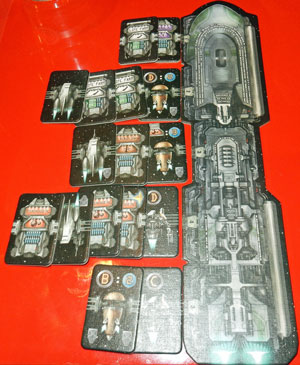
I’m loaded up with modules: now, off to Reworld!
The types of module each have a different function: terrabots found cities, builders extend them and shuttles are needed to get the builders down to the planet's surface. To gain modules, players must use the 'Officer' cards in their hand. This starts off simple, but gets tougher as modules are replaced by officers and cards must match the adjacent officers. Once acquired, a module is added to one of the docking slots on the player's carrier, with subsequent modules going outside those already there.
Once all the officer cards have been used, the round ends. A fresh crop of modules is then laid out. After five rounds of this, all the modules will have been made available (though not necessarily taken) and it's time to move on to chapter two. Now players must deploy one module at a time. The problem is that they can only take modules from the outside of docking slots. Ah: suddenly the order in which you got the modules becomes important!
As players found and expand their cities, they look for opportunities to take the 'population ship' tiles, which score points. Each of these has a different condition: first player to empty slot '1' on their carrier, say, or first to have at least eight tiles in a city. Yes, the order you took the modules becomes very, very important - along with the sequence you deploy them. Oh, this is a clever game: I give full marks to Messrs Kiesling and Kramer.
I thoroughly enjoyed Reworld, despite John consistently taking scoring tiles the turn before I could. It resonates with the programmer in me and I was very pleased that I was able to deploy all my modules usefully. Just too slowly, clearly. There are decisions to be made, but there's also a luck element and the whole thing was good fun. It gets a provisional 9/10 on my highly subjective scale.
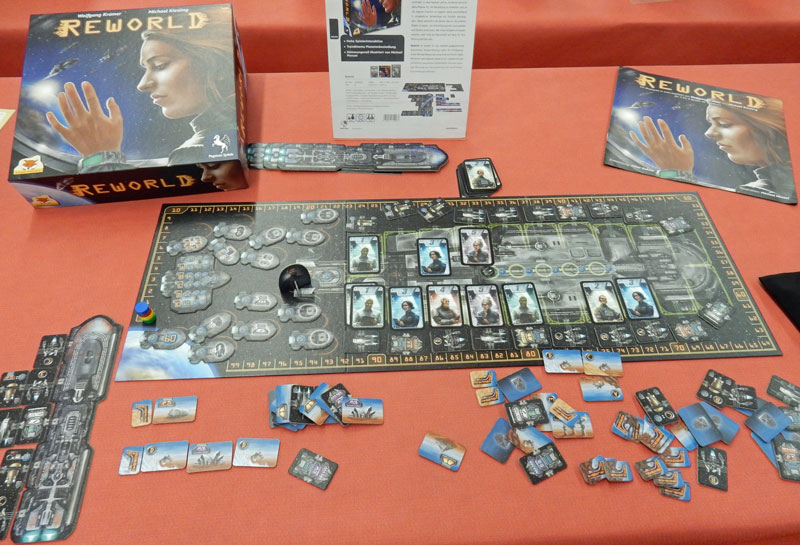
The full Reworld display at the new games exhibition
Fighting the crowds on Saturday
After a late night (later than I had expected) on Friday evening, we did not make a prompt start on Saturday. This is also the busiest day of the show, so it was slow work getting around the halls. Back in hall 7 again, we found Game Brewer from Belgium with the bizarre looking Chimera Station and the elfin Pixie Queen. The first involves mixing body parts from different aliens, to weird effect, while the second is a dark-looking game of tormenting humans. However, we played their third game, Castellum, designed by Erik Scheele.
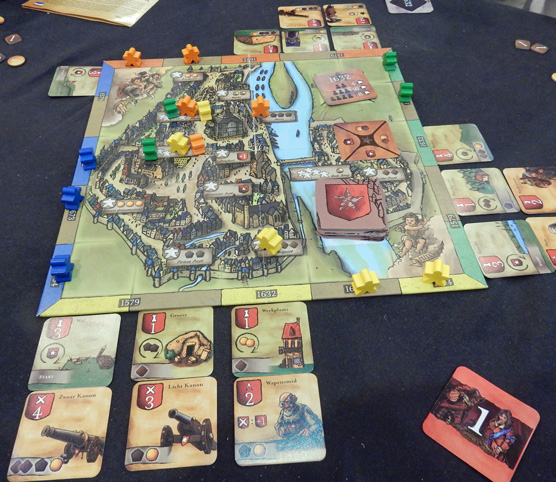
Building up my defences for the next siege in Castellum
This is a card-based wargame featuring the city of Maastricht under siege through the Middle Ages. It's played over four rounds, each representing a historical siege - from Spanish troops in 1579 to the French in 1794. The players are all defending Maastricht, which leads to a nice element of cat-and-mouse as, between them, the players need to defeat the attacking forces, but are also vying for the upper hand between the defenders. The trick is knowing just how far to push things.
Players start with a few worker pawns (increasing as the rounds go on) and resources. They use them to buy the square cards that represent troops and fortifications of different types, placing these to form columns at their side of the central board. Cards also provide income, so there are several factors to weigh up when choosing what to buy. There are also 'angel' cards that provide bonuses or special actions for use later on.
Players then get some attacking cards and place them against the columns of defenders - their own or other players'. Clearly, you want weak attacks against your own troops, while putting stronger ones against your opponents. However, the Angel of Maastricht now comes into play as players use their angels to mix things up: swapping over two enemy cards, for instance. Only then do the players resolve the actual siege, taking the enemy cards they defeat.
If enough enemy cards are defeated, players get rewards, the distribution being decided by the player who contributed most to the victory. Time for Maastricht to be besieged again! After all four sieges have been resolved, players score according to stars on defeated enemies (one reason you might want to take on a stronger enemy card), with extra points for leftover resources and special troops. The player with the most points wins, of course.
Castellum has some clever features, relatively simple rules and plays quite quickly. Players need to think a bit and make some significant decisions. While I enjoyed the game, I'm not sure I need to play it again, so it gets 6/10 on my highly subjective scale.
Moving on around the hall, we came across Brides and Bribes. This has an interesting theme: intrigue in Renaissance Genoa to win the hand of the Doge's daughter. Designed by Andrea Gallazzi, Elisa Lenardi and Pietro Navarotto, it is published by Spaceballoon Games in Switzerland. Players represent the other noble houses in Genoa, vying to advance their own position. They do this by despatching 'delegations' (character tile/s) to the city's Boroughs. Once all the delegations have been placed, the Boroughs are resolved, allowing players to carry out actions. Unless the other players' delegations get in the way by, say, poisoning an opposing delegate. Yes, it's that kind of game!
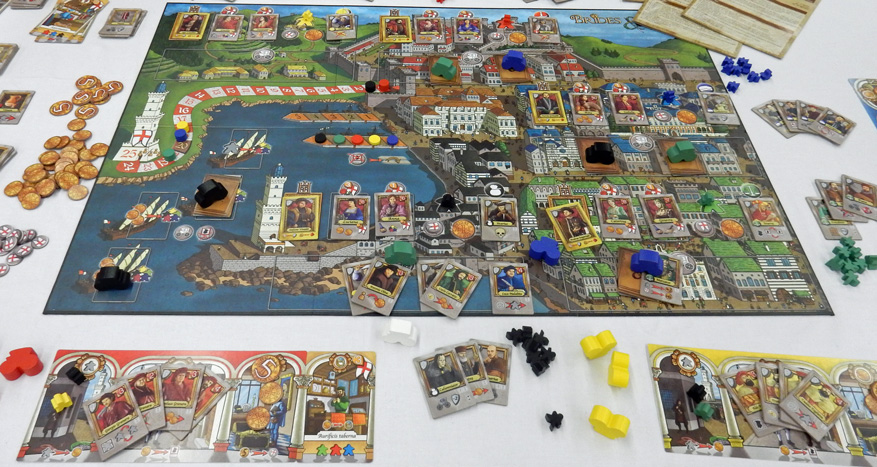
Brides and Bribes on display
In order to marry the Doge's daughter, players must meet the requirements and pay the dowry - using resources gathered by those delegations. Of course, even the Doge's daughter could be poisoned. But he has another one... Brides and Bribes looks terrific fun, as players try to gain the resources they need while stopping everybody else. I look forward to playing it, but give it a provisional 8/10 on my highly subjective scale for the time being.
Close by was Italian publisher Placentia with Wendake, a game with an obvious Native American theme. Designed by Danilo Sabia, the game focuses on everyday life, with each player managing their own tribe's activities. Pete and I played through a couple of rounds to get the idea of the game. Players have markers for the male and female members of their tribe, plus wooden pieces for the warriors and canoes.
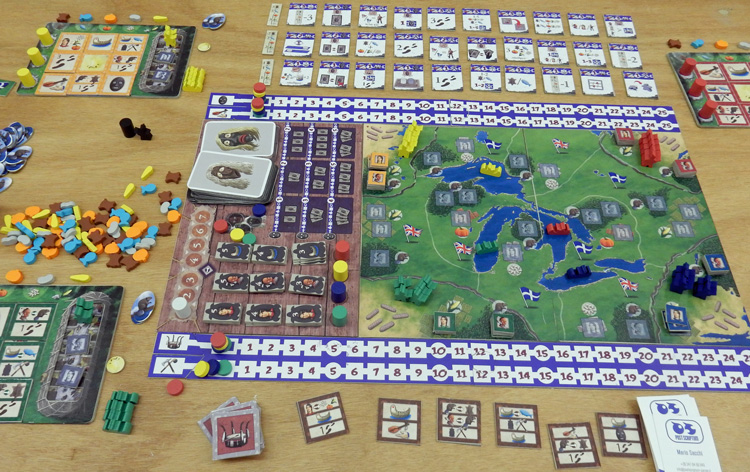
Displaying Wendake at the new games exhibition
Players take actions by placing a wooden cylinder on the appropriate space on their own board. Across their three turns in a round, these must form a line, so players are not just selecting one action, they're deciding which set of three they want to carry out - though placing in the middle initially provides flexibility. Players can fish and harvest to gather food, hunt to provide pelts for trading or carry out rituals to score points. Trading allows the tribe to develop, gaining tiles that provide discounts or bonuses. Each round, the actions available change, giving players different opportunities and challenges as the game progresses.
Not everything is peaceful between the tribes, however, and players can use their warriors to remove other players' tribe members from an area so that they can move in their own. They can also choose to get involved in the ongoing wars between the French and British, but this is only a minor component of the game. The result is an entertaining development game with a bucolic feel to it - it just seems very peaceful. There are extensive historical notes and players have the option of choosing specific historical tribes to add a bit more flavour into the game. I quite enjoyed my introduction and give Wendake a provisional 7/10 on my highly subjective scale.
Around the corner we found a new name to me, Desyllas Games from Greece. Family and children's games are the publisher's stock in trade, but Pete and I had a go at Sultans of the Wind, designed by Jan Meyberg. This is a family game of getting flying carpets across a maze of clouds. The board is laid out with a grid of tiles showing sky - and white clouds. Plus a genie pawn in the centre. Players each start on one side of the board with their chunky wooden 'carpet' pieces and aim to get these to the palace directly opposite.
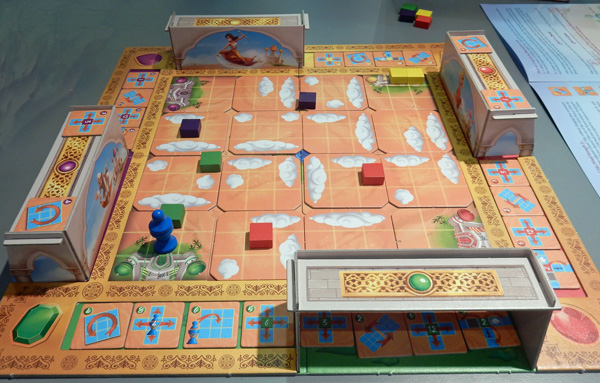
Playing Sultans of the Wind: Red is using the Genie well, but Green is blocked
They do this by playing two 'Wind' tiles each turn. There's a neat recycling mechanism that means each player only has four of their set of eight available each turn and, once played, a tile won't re-appear for the next two turns. The first problem is those clouds: carpets can't go through them. However, while most Wind tiles move a carpet, others let you move or rotate part of the 'sky' or shift the Genie - gaining an extra move.
Okay, it's not the deepest game, but it is fun and there's still a challenge in navigating around the ever-changing maze produced by the clouds. There's a real need to think ahead, too, or you'll be left with Wind tiles you simply can't use. I give Sultans of the Wind a provisional 7/10 on my highly subjective scale.
 Tucked into one corner of hall 7, I came across Spanish publisher 2Tomatoes. They were demonstrating Peak Oil. Designed by Tobias Gohrbandt and Heiko Günther, this is a game of the modern day oil industry. Players are oil corporations, facing
up to the imminent depletion of oil reserves around the world. In the game, the oil (black wooden barrel pieces) will run out, it's just a matter of when. Hence the corporations are clandestinely investing in start-up companies developing alternative energy sources.
Tucked into one corner of hall 7, I came across Spanish publisher 2Tomatoes. They were demonstrating Peak Oil. Designed by Tobias Gohrbandt and Heiko Günther, this is a game of the modern day oil industry. Players are oil corporations, facing
up to the imminent depletion of oil reserves around the world. In the game, the oil (black wooden barrel pieces) will run out, it's just a matter of when. Hence the corporations are clandestinely investing in start-up companies developing alternative energy sources.
While the oil barrels last, players will still produce oil as this is the finance for their investments. There is a clever action mechanism that limits the actions players can take each turn. They must also watch out for investigative journalists digging the dirt on their corporation - you can't avoid this, but can hope to minimise the damage. It looks an interesting, challenging game and I picked up a copy, so expect a full review in due course. For the time being, Peak Oil gets a provisional 8/10 on my highly subjective scale.
Strolling through into hall 8, I was pleased to meet Tim Fowers, main man at Fowers Games and designer of Paperback, the deck-building word game which I rather like, and co-operative heist game, Burgle Bros. Tim had the commercial edition of Burgle Bros on show, but only a prototype of Hardback, his "prequel" to Paperback. It was successfully funded on Kickstarter, but has been hit by production delays. I'm eagerly awaiting my copy...
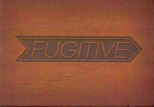 Tim gave me a review copy of Fugitive, his two-player hidden movement game and I've played it a few times since. One player takes the role of the Fugitive, trying to escape, while the other is the Marshall - guess what their goal is... The main component is a deck of cards, numbered 1-42. The Fugitive escapes if they successfully play card 42, but they're caught if the Marshall is able to work out
all the cards they've played.
Tim gave me a review copy of Fugitive, his two-player hidden movement game and I've played it a few times since. One player takes the role of the Fugitive, trying to escape, while the other is the Marshall - guess what their goal is... The main component is a deck of cards, numbered 1-42. The Fugitive escapes if they successfully play card 42, but they're caught if the Marshall is able to work out
all the cards they've played.
The Fugitive starts with cards 1-3 and 42. The rest are divided by number into three draw decks and the Fugitive draws a few more. Then, each turn they draw a card and play card/s. The first card the Fugitive plays (face-down) is their next 'Hide-out'. It can't have a number more than three greater than their previous hide-out. Except that the cards also show a number of footprints and the Fugitive can play extra cards (still face-down), using the footprints to play a higher value hide-out.
In their turn, the Marshall draws two cards - crucial, as it gives them some definite places where the Fugitive isn't - and may guess a hide-out. If they are correct, the hide-out card and any attached footprints are turned over. The Marshall can also guess several hide-outs, but these are only turned over if the Marshall gets them all right, so it's a high risk tactic. Though it can be useful to fill in gaps if the Marshall's got a recent hide-out, but not all the previous ones.
I've played this several times now (and it's been a useful two-player option at Swiggers games club) and it's roughly even between Marshall and Fugitive. As/when I get to play it with someone who's played it before, we'll add in the 'Event' cards that mix things up a bit. Such as the 'Barking Dog' that forces the Fugitive to play at least one footprint on their next turn. Fugitive is a cracking little game and gets a solid 8/10 on my highly subjective scale (despite my aversion to two-player games). It means I now have two standard two-player games in my bag: Fugitive and The Cousins' War.
Working our way back again, Pete and I came across 4Hogs, a Croatian publisher who insisted we give Skull Port a go. How could we refuse? Especially when it's the co-designer, Hrvoje Kordic, inviting us - his partner in game design is Ivan Ferencak. This is a pirate-themed dice game, where players roll the dice to make scoring sets, Yahtzee-style - two pairs, three of a kind, full house and so on. Each set is associated with a pirate ship and rolling the set lets you place one of your tokens into the crew. The best slot is Captain, of course, but there are two other spaces. If the space you want is occupied, you push the others down - if your token is a higher value.
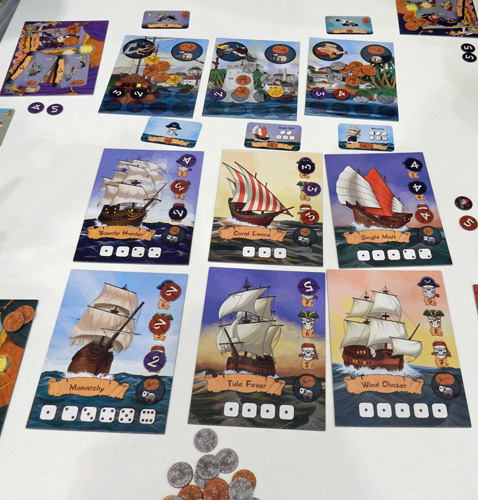
Skull Port in play
When a token is pushed out completely (which will happen), it is moved to one of the Port cards instead. This is also where tokens go if a player doesn't make a set on their turn. Having tokens on a Port card isn't all bad. Players can place cash on a Port to use its ability to change their dice roll. At the end of the game, players with influence on Ports divvy up the cash that's accumulated. Players' scores are the totals of the value of their positions on ships plus their cash, so it's well worth picking up the money - as Hrvoje demonstrated.
Players get cash according to the 'Fleet' cards that are in play. For example, taking a Captain's position will give you a doubloon, if the right card is in play. Another card would give you two doubloons for rolling a full house. Hence, you're not just rolling the dice for the ship positions they will give you, but also to provide cash. There are also 'Captain's Bonus' cards, which players can buy and may have up to two active at a time. These are another way of gaining cash, or victory points or even an extra die. (I'll have that, thank you.)
The game lasts ten rounds, after which players dish out the money from the ports and see who's won. We found Skull Port very entertaining. Yes, there's a huge luck element, but this just adds to the fun! I did think it went on a little too long, but I still enjoyed myself. It gets a provisional 7/10 on my highly subjective scale.
With Saturday drawing to an end, Pete and I were drifting towards the exit when we spotted Asyncron Games - publisher of the delightful L'Aéropostale a few years ago. We couldn't resist having a go at the prototype on the table: Pelegrinus, designed by Julien Nigon. The theme of this game is the spread of Christianity (monastic orders, specifically) across Europe.
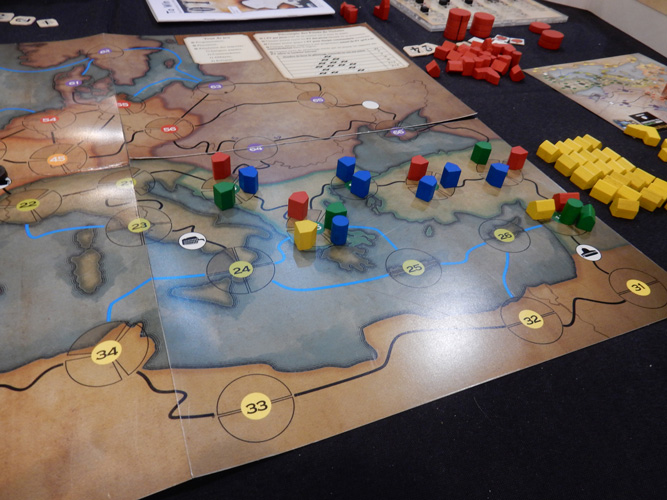
Playing the Pelegrinus prototype: the church has only spread to Asia Minor, but we’re squabbling already
Players have a set of pawns of differing values, which they allocate each round - initially only in the Holy Land, of course, but other regions become accessible as the game goes on. Where there are too many pawns in a location, precedence will decide who stays and who goes. Then those who remain can establish monastic communities of specific eminence. The aim is to dominate a region, but locations on one of several pilgrimage routes are particularly useful as they provide income.
Alternatively, players can use their pawns to gain favour at the Papal court - providing a useful advantage - or to get control of important relics. It was a thoroughly engaging game with plenty to think about and lots of options. I give Pelegrinus a provisional 7/10 on my highly subjective scale and look forward to seeing the finished article - expect it on Kickstarter in due course.
Saturday evening at the Hotel Jung is whisky evening! Except that's one tipple I don't care for. Instead, Chris Dearlove introduced me to (The Quest for) El Dorado, a new game from Reiner Knizia, published by Ravensburger. I don't bother visiting Ravensburger at Spiel as a rule - their output is overwhelmingly children's games and jigsaw puzzles - so I missed this one at the show. To some extent, this is Reiner's take on Dominion-style deck-building. Players play from their hand of cards (just four) to move their expedition along the board and/or buy a new card, which goes into their discard pile. They then draw from their own deck of cards to bring their hand back up to size, shuffling the discards when their deck runs out.
However, the cards in this game are a means to an end, not an end in themselves. That end is being first to traverse the 'board' and reach the fabled lost city (it's a race!). The board is actually several boards showing different types of terrain (jungle, desert, mountain et al, each with their own symbol) in a hexagonal grid. These can be assembled in numerous different ways and the game's length depends on how many boards are used. To move, players play cards with the appropriate symbols to move onto spaces showing those symbols. Thus, it's good to have jungle cards (showing a machete) when your expedition is in the jungle, but they're not so useful when you reach the desert.
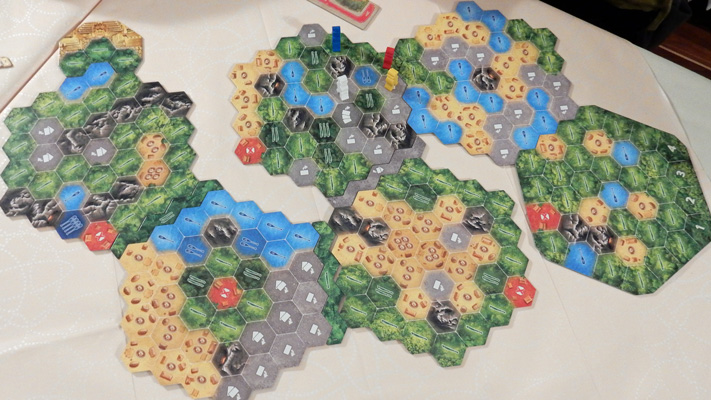
Playing El Dorado – we’ve just made it to the third tile and it’s pretty close so far
What's more, all cards have another use: buying new cards. Some cards show gold coins at the top and are worth that amount - all other cards are worth 1/2 a coin. The coins at the bottom of a card are what it costs to buy. Hence, a key decision each turn is whether to move or buy, though this is often dictated by the cards you hold - being able to move and buy is a luxury that doesn't happen that often. And some cards - the more powerful ones - go out of the game once played.
There's one final twist: in between each board is a zig-zag piece of cardboard - a 'barrier'. The first player to move from one board onto the next one must use extra symbols to remove the barrier. The obvious thing this does is slow down the leader. However, the number of barriers collected is the tie-breaker if more than one player reaches El Dorado at the end of the game (triggered by the first to reach the goal). El Dorado may have relatively simple mechanisms, but it's more complicated to play. I give it a provisional 8/10 on my highly subjective scale and expect to see more of it in the coming months.
Wrapping up the loose ends on Sunday
On Sunday I wanted to catch up with some of the publishers I hadn't managed to visit yet. So it was back into hall 7 for Pete and me to find Moaideas Game Design, the Taiwanese publisher whose Flow of History I was very taken with last year. This year their new game is Tulip Bubble, designed by Kouyou. As with last year's game, this has large cards as its main component. In this case, they are gorgeously illustrated with drawings of different varieties of tulip. Not just the simple red or yellow bell, but more ornate shapes, colours and patterns - with the black tulip as the ultimate flower.
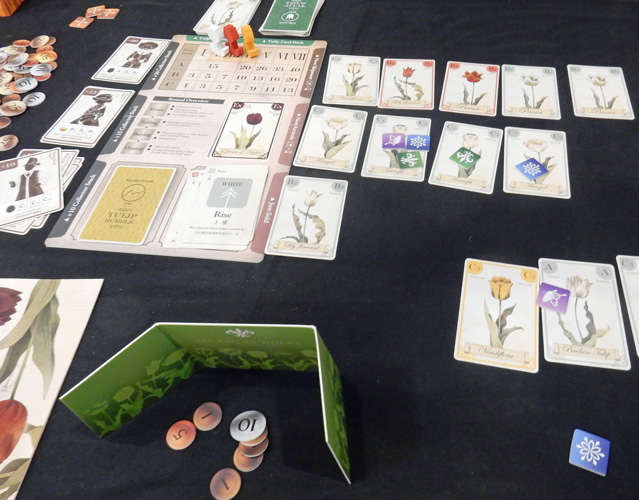
Playing Tulip Bubble
However, the game is more about the market for tulip bulbs and the 17th century bubble of tulipmania. Thus players are buying and selling tulips, aiming to buy low and sell high, of course. To buy, players place markers on the tulip cards they want from the market. If more than one player wants a particular card, an auction takes place, with the card going to the high bidder. In a neat touch, players may 'finance' their purchase, borrowing money against the collateral of the tulip. All fine and dandy if they can sell the tulip at a profit...
And the rub is, of course, the way market prices change. At the start of a round, they will be adjusted according to a random event. At the end of the round, the price of each type goes down if it's the most numerous remaining in the market and up if it's the least. Thus, buying several of a tulip may push the price up. However, the most profitable way of selling tulips is to provide a 'collector' with the set they are after - the collector card is then replaced with a new one.
The game ends either when one player has enough money to buy the black tulip and win outright or when the bubble bursts. Suddenly, players' tulips are worth nothing and the banks call in their loans. The player with the most money wins. My introduction to Tulip Bubble certainly whetted my appetite to play the game properly. The terrific illustrations on the cards add to the game's appeal and I give it a provisional 8/10 on my highly subjective scale.
Strolling into hall 6 we found the Wizkids stand. The game that got Pete's and my attention was Empires. Not least because it was spread over several tables with demo games involving up to 10 players. We hung around to get in on the next demo. As the name suggests, Empires - designed by Daniel and David Stephenson - is about expanding empires. In this case, it's the empires of the 19th century European powers. However, there's no map in the game. Like everything else, geography has been abstracted to cards, tiles and tokens. The heart of the game is negotiation: players can trade anything in the game. And that does mean anything: if you chose Britain as your nation at the beginning of the game, you can still trade that (assuming you think it's worth it), giving someone else Britain's special ability.
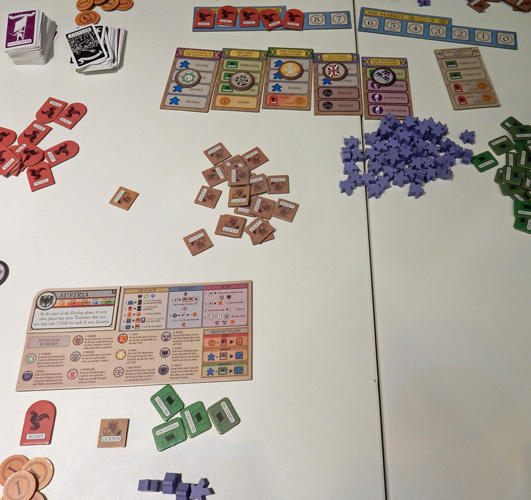
Demo game of Empires – across two tables
Having said that, the game's mechanisms do provide some structure. The first thing that happens each round is that players develop their empire: assigning their population to produce things, paying the interest on the bonds they've taken out to finance their empire, building new stuff and so on. There are penalties (Revolt cards) if players don't manage their empire properly. Then they sell the goods they've produced. Money is used to buy armies and players then take 'War' tiles in order of the number of armies they have. The wars provide players with new assets and that's the end of the round. Because everything can be traded, you don't necessarily need to plan to get the right balance of assets: you can take the most and then trade to get what you need.
Based on our experience of playing through a few rounds (with seven players), I'd happily play this game even without the trading. As I found, you can do okay in the game with a minimum of dealing. However, as our demonstrator proved, making lots of deals where you gain a little each time will always do better. This is a terrific game that I look forward to playing. Empires gets a provisional 9/10 on my highly subjective scale.
I was pleased to see Portuguese publisher MESA Boardgames back at Spiel - it's been a few years. Their new game is Viral, designed by Antonio Sousa Lara and Gil d'Orey (with the US version from Arcane Wonders. The bright colours and simple artwork on the board may make it look like childish, but it's a surprisingly subtle tactical game. Players are viruses, invading the organs of a human body. They score points for having the majority in a set of organs (the two lungs, for example), but having lots of viruses in an area will attract the body's white corpuscles or even prompt an inoculation, killing off viruses.
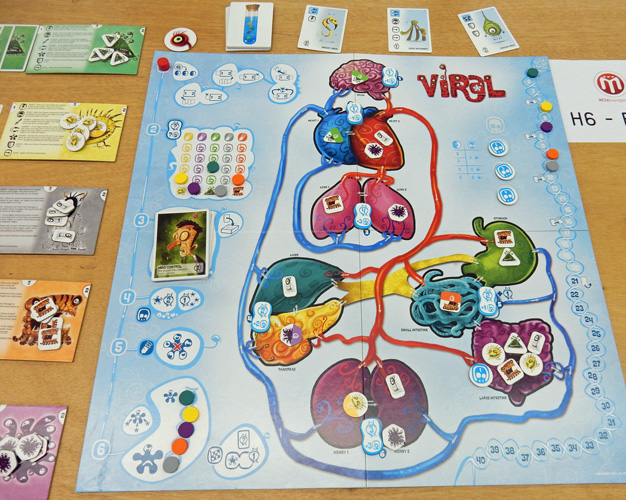
The colourful Viral on display
Players' actions are driven by their set of cards - each player has an identical set initially. These let players place or move their virus tokens. Everybody secretly plays a pair of cards: one showing an action, the other an area. These are then resolved in player order and players play a second pair. Only then can players pick up the cards they played last round. This means you really need to think about what you're going to do next turn as well as the current one.
Players score points according to who controls each area - which can be nobody. Scoring points also moves a player's marker up a chart, which will trigger an inoculation against that virus when the marker reaches the top of the chart. On top of this, as a player's score increases, they will get the opportunity to add cards to their hand, giving them different and stronger movement options - though just having extra cards is useful.
The final twist is the tie-breaker table: at the end of each round, this is set in reverse order of players' scores, thus giving low-scoring players the advantage over higher scorers. Pete and I had good fun playing Viral and players' decisions are anything but obvious, so there's plenty to think about. It gets a provisional 8/10 on my highly subjective scale and I expect to be playing it a lot more.
My last call (apart from collecting a few more things for Games from Pevans) was at Abacusspiele for a brief chat with main man Joe Nikisch. Abacus's new releases included the German editions of Century: Spice Road and NMBR 9, both of which I encountered at this year's Gathering (see my report in TWJO 174), the Diamante set of expansions for Cacao and Zooloretto Duell, Michael Schacht's two-player version of his zoo-building game, Zooloretto.
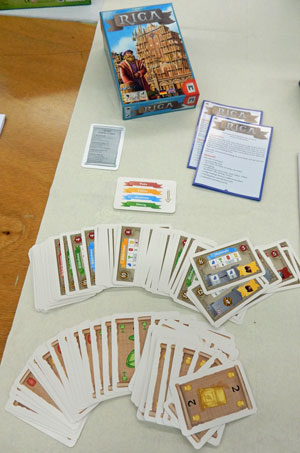
Riga on display
Also on the Abacus stand was Stefan Risthaus of Ostia Spiele with his latest design, Riga. (Given Stefan's game last year was Tallinn, I'm expecting Vilnius next year...) This is a another clever little card game, centred on the medieval city of the title. Players are traders vying to expand around the Baltic Sea from their base in the city. They draft sets of 'commodity' cards to provide the resources they need to play building cards in four other cities.
The twist is that, while there is a standard value for each commodity, some of them have a premium value, depending on the specific building they're being used for. The aim is thus to make the most efficient use of the cards by collecting goods that are worth more for the buildings you hold and buildings that are cheaper for the goods you hold. On top of this, buildings also provide special abilities.
After a set number of rounds, the player with the most valuable buildings wins, after subtracting points for any buildings left in their hand. It's not too demanding, but there's more than enough going on to keep players attention throughout the game. Stefan let me have a review copy, so expect more about Riga in due course. For the time being, I give it a provisional 7/10 on my highly subjective scale.
And that was that at Spiel for another year. My journey home was delayed a bit by a motorway closure in Kent, but was otherwise uneventful. As always, many thanks to Dominique Metzler and the team at Friedhelm Merz Verlag for their hard work in putting together another fine event. Spiel '18 is scheduled for 25th-28th October 2018 - dates that are already in my diary.
All trademarks acknowledged. Game artwork courtesy of the publisher.
Photos were taken by Pevans, who played with Photoshop.
This report was first published in To Win Just Once issues 179 and 180 (November and December 2017).
